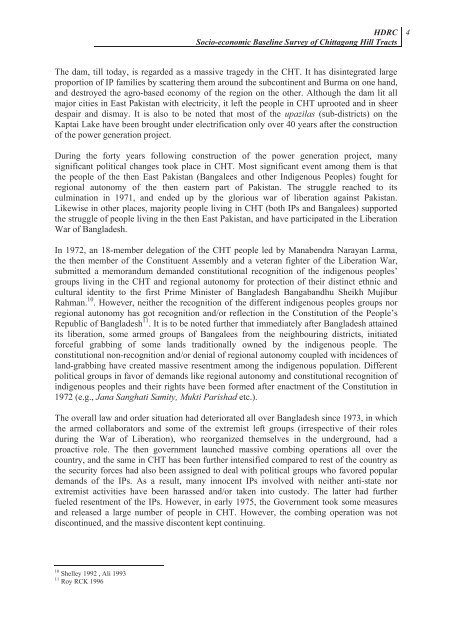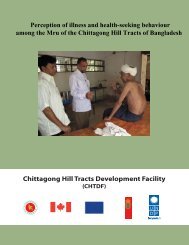Socio-economic Baseline Survey of Chittagong Hill Tracts - chtdf
Socio-economic Baseline Survey of Chittagong Hill Tracts - chtdf
Socio-economic Baseline Survey of Chittagong Hill Tracts - chtdf
- No tags were found...
Create successful ePaper yourself
Turn your PDF publications into a flip-book with our unique Google optimized e-Paper software.
HDRC<strong>Socio</strong>-<strong>economic</strong> <strong>Baseline</strong> <strong>Survey</strong> <strong>of</strong> <strong>Chittagong</strong> <strong>Hill</strong> <strong>Tracts</strong>4The dam, till today, is regarded as a massive tragedy in the CHT. It has disintegrated largeproportion <strong>of</strong> IP families by scattering them around the subcontinent and Burma on one hand,and destroyed the agro-based economy <strong>of</strong> the region on the other. Although the dam lit allmajor cities in East Pakistan with electricity, it left the people in CHT uprooted and in sheerdespair and dismay. It is also to be noted that most <strong>of</strong> the upazilas (sub-districts) on theKaptai Lake have been brought under electrification only over 40 years after the construction<strong>of</strong> the power generation project.During the forty years following construction <strong>of</strong> the power generation project, manysignificant political changes took place in CHT. Most significant event among them is thatthe people <strong>of</strong> the then East Pakistan (Bangalees and other Indigenous Peoples) fought forregional autonomy <strong>of</strong> the then eastern part <strong>of</strong> Pakistan. The struggle reached to itsculmination in 1971, and ended up by the glorious war <strong>of</strong> liberation against Pakistan.Likewise in other places, majority people living in CHT (both IPs and Bangalees) supportedthe struggle <strong>of</strong> people living in the then East Pakistan, and have participated in the LiberationWar <strong>of</strong> Bangladesh.In 1972, an 18-member delegation <strong>of</strong> the CHT people led by Manabendra Narayan Larma,the then member <strong>of</strong> the Constituent Assembly and a veteran fighter <strong>of</strong> the Liberation War,submitted a memorandum demanded constitutional recognition <strong>of</strong> the indigenous peoples’groups living in the CHT and regional autonomy for protection <strong>of</strong> their distinct ethnic andcultural identity to the first Prime Minister <strong>of</strong> Bangladesh Bangabandhu Sheikh MujiburRahman. 10 . However, neither the recognition <strong>of</strong> the different indigenous peoples groups norregional autonomy has got recognition and/or reflection in the Constitution <strong>of</strong> the People’sRepublic <strong>of</strong> Bangladesh 11 . It is to be noted further that immediately after Bangladesh attainedits liberation, some armed groups <strong>of</strong> Bangalees from the neighbouring districts, initiatedforceful grabbing <strong>of</strong> some lands traditionally owned by the indigenous people. Theconstitutional non-recognition and/or denial <strong>of</strong> regional autonomy coupled with incidences <strong>of</strong>land-grabbing have created massive resentment among the indigenous population. Differentpolitical groups in favor <strong>of</strong> demands like regional autonomy and constitutional recognition <strong>of</strong>indigenous peoples and their rights have been formed after enactment <strong>of</strong> the Constitution in1972 (e.g., Jana Sanghati Samity, Mukti Parishad etc.).The overall law and order situation had deteriorated all over Bangladesh since 1973, in whichthe armed collaborators and some <strong>of</strong> the extremist left groups (irrespective <strong>of</strong> their rolesduring the War <strong>of</strong> Liberation), who reorganized themselves in the underground, had aproactive role. The then government launched massive combing operations all over thecountry, and the same in CHT has been further intensified compared to rest <strong>of</strong> the country asthe security forces had also been assigned to deal with political groups who favored populardemands <strong>of</strong> the IPs. As a result, many innocent IPs involved with neither anti-state norextremist activities have been harassed and/or taken into custody. The latter had furtherfueled resentment <strong>of</strong> the IPs. However, in early 1975, the Government took some measuresand released a large number <strong>of</strong> people in CHT. However, the combing operation was notdiscontinued, and the massive discontent kept continuing.10 Shelley 1992 , Ali 199311 Roy RCK 1996



